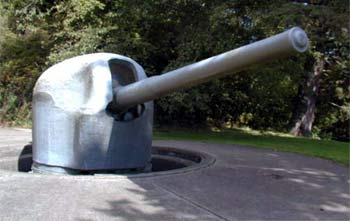Battery Barnes BCN-240
Twin six-inch armored turret guns
|

An example of the
newly designed 6" Coast Artillery Gun
identical to the ones installed at Battery 240 is currently
on exhibit at Fort Columbia in
Chinook, Washington. |
Beginning in about 1940 the
United States began to take another serious look at the
state of it's coastal defenses. As a result of that
re-evaluation dozens of forts around the country were slated for modernization.
The work was slow but
America's entry into World War Two accelerated the building
program. In April of 1942 work
began at the Point Vicente Military Reservation about eight
miles north of Fort MacArthur. This new battery was designed
to cover the northern entrance to the Catalina Channel. |
By the beginning of World War
Two, the army had abandoned the practice naming it's guns
for famous people from it's past. Instead the vast majority
of the new batteries are just referred to by their
construction codes. Battery 240 is the 40th battery of the
200 series construction plan.
In January 1948, section II
of General Order 1 issued by the War Department, renamed
Battery 240 to honor Colonel Harry C Barnes, of the US Army
Coast Artillery Corps. Less than a year later, the guns
would be removed and the equipment sold for scrap.
The Point Vicente Military
Reservation remained in government hands until 1977, first
as a training area, and later as the Launch and
administration area for
NIKE missile site LA-55. Today all of the NIKE era buildings have
been slightly remodeled and now used as the City Hall for
the community of Rancho Palos Verdes. The NIKE missile launch area
is used as a city storage and maintenance yard and Battery Barnes is owned by the
US Coast Guard who uses it as a radio beacon and aid to
navigation.
|
Battery Barnes is named for Colonel
Harry C. Barnes, who entered US Army service as a captain
with Company "I," First
Territorial Volunteer Infantry, 1898-99. He Re-entered
the military service in 1899 as first lieutenant in
the 34th Volunteer Infantry; in service during the
Philippine insurrection 1899-1901; promoted to captain
and decorated with the Silver Star medal for gallantry
in action. He remained in the military and later he was transferred to the Coast
Artillery Corps where he rose to the grade of colonel;
served in the American expeditionary forces during
World War 1 as colonel
of artillery and awarded the Distinguished Service
Medal. |
|
|
 |
|
The Guns of Fort MacArthur |
 |
|
|
|